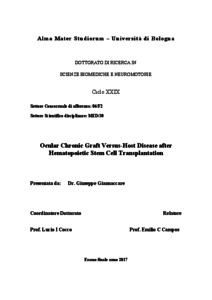Giannaccare, Giuseppe
(2017)
Ocular Chronic Graft Versus-Host Disease after Hematopoietic Stem Cell Transplantation, [Dissertation thesis], Alma Mater Studiorum Università di Bologna.
Dottorato di ricerca in
Scienze biomediche e neuromotorie, 30 Ciclo. DOI 10.6092/unibo/amsdottorato/7943.
Documenti full-text disponibili:
![[img]](http://amsdottorato.unibo.it/7943/6.hassmallThumbnailVersion/Giannaccare_Giuseppe_tesi.pdf)  Anteprima |
|
Documento PDF (English)
- Richiede un lettore di PDF come Xpdf o Adobe Acrobat Reader
Disponibile con Licenza: Salvo eventuali più ampie autorizzazioni dell'autore, la tesi può essere liberamente consultata e può essere effettuato il salvataggio e la stampa di una copia per fini strettamente personali di studio, di ricerca e di insegnamento, con espresso divieto di qualunque utilizzo direttamente o indirettamente commerciale. Ogni altro diritto sul materiale è riservato.
Download (1MB)
| Anteprima
|
Abstract
Graft-versus-host disease (GVHD) is a potentially severe complication that may develop in different tissues including the eye after allogenic hematopoietic stem cell transplantation (HSCT).
The purpose of this research project was to evaluate ocular surface parameters of patients undergoing HSCT before and after transplantation, and to correlate them with clinical and HSCT features.
Data from the charts of ninety-three patients affected by hematological malignancies undergoing HSCT were collected. Values of Ocular Surface Disease Index, Schirmer Test type I, Tear Film Break-up Time, ocular surface staining and Meibomian Gland Dysfunction score obtained before HSCT and 3-6 months after were retrieved from charts. Diagnosis and staging of Dry Eye disease (DED) was performed according to Dry Eye WorkShop criteria. GVHD was classified according to the National Institutes of Health (NIH) 2015 Criteria. Odds ratios for DED onset after HSCT were estimated for demographic, ocular, hematological and HSCT features.
Dry eye disease was diagnosed before HSCT in 50 (53%) of the patients, mostly of hyper-evaporative profile. After HSCT all ocular parameters significantly worsened with no change in DE profile. A 51% of incident cases (22 on the 43 non-DE subjects) were reported. Increasing recipient age and female sex, higher CD34+ cells infused, donor-recipient sex mismatch (males receiving from females), related donors, and peripheral blood cells as stem cell source were associated with a significant higher incidence of DED after HSCT. Systemic chronic GVHD was diagnosed in 42% while ocular GVHD in 35.5% of the patients, which decreased to 12% when taking into account only incident cases.
In conclusion, a high DE prevalence was shown already before HSCT. Therefore, an ocular surface assessment should be recommended already before HSCT for early DED diagnosis and treatment. This new protocol also could influence the real prevalence of ocular GVHD after HSCT and its severity.
Abstract
Graft-versus-host disease (GVHD) is a potentially severe complication that may develop in different tissues including the eye after allogenic hematopoietic stem cell transplantation (HSCT).
The purpose of this research project was to evaluate ocular surface parameters of patients undergoing HSCT before and after transplantation, and to correlate them with clinical and HSCT features.
Data from the charts of ninety-three patients affected by hematological malignancies undergoing HSCT were collected. Values of Ocular Surface Disease Index, Schirmer Test type I, Tear Film Break-up Time, ocular surface staining and Meibomian Gland Dysfunction score obtained before HSCT and 3-6 months after were retrieved from charts. Diagnosis and staging of Dry Eye disease (DED) was performed according to Dry Eye WorkShop criteria. GVHD was classified according to the National Institutes of Health (NIH) 2015 Criteria. Odds ratios for DED onset after HSCT were estimated for demographic, ocular, hematological and HSCT features.
Dry eye disease was diagnosed before HSCT in 50 (53%) of the patients, mostly of hyper-evaporative profile. After HSCT all ocular parameters significantly worsened with no change in DE profile. A 51% of incident cases (22 on the 43 non-DE subjects) were reported. Increasing recipient age and female sex, higher CD34+ cells infused, donor-recipient sex mismatch (males receiving from females), related donors, and peripheral blood cells as stem cell source were associated with a significant higher incidence of DED after HSCT. Systemic chronic GVHD was diagnosed in 42% while ocular GVHD in 35.5% of the patients, which decreased to 12% when taking into account only incident cases.
In conclusion, a high DE prevalence was shown already before HSCT. Therefore, an ocular surface assessment should be recommended already before HSCT for early DED diagnosis and treatment. This new protocol also could influence the real prevalence of ocular GVHD after HSCT and its severity.
Tipologia del documento
Tesi di dottorato
Autore
Giannaccare, Giuseppe
Supervisore
Dottorato di ricerca
Ciclo
30
Coordinatore
Settore disciplinare
Settore concorsuale
Parole chiave
Ocular Graft versus-host disease; Dry eye disease; Hematopoietic stem cell transplantation.
URN:NBN
DOI
10.6092/unibo/amsdottorato/7943
Data di discussione
23 Maggio 2017
URI
Altri metadati
Tipologia del documento
Tesi di dottorato
Autore
Giannaccare, Giuseppe
Supervisore
Dottorato di ricerca
Ciclo
30
Coordinatore
Settore disciplinare
Settore concorsuale
Parole chiave
Ocular Graft versus-host disease; Dry eye disease; Hematopoietic stem cell transplantation.
URN:NBN
DOI
10.6092/unibo/amsdottorato/7943
Data di discussione
23 Maggio 2017
URI
Statistica sui download
Gestione del documento:


 Login
Login
